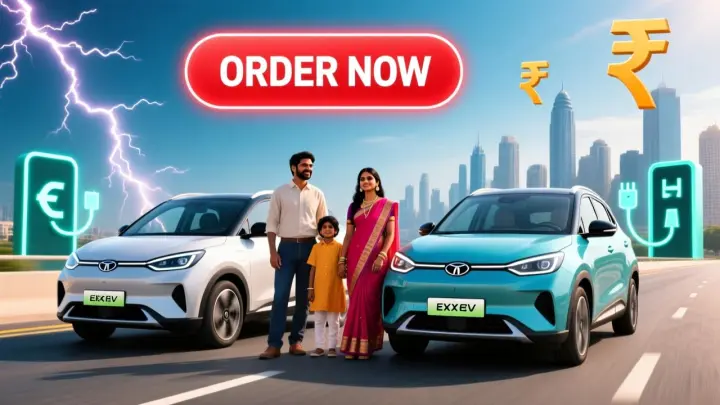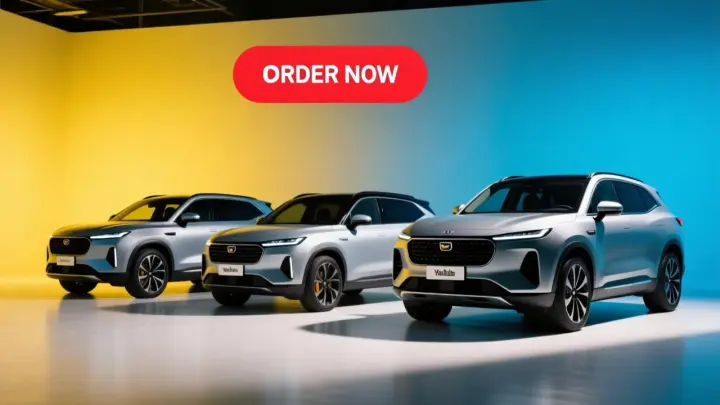Find the best car under ₹15 lakh in India for your family. Our comprehensive 2025 guide compares top petrol, hybrid, and EV models on price, mileage, safety, and features. Make an informed choice with our detailed analysis.
The year is 2025, and the road ahead is more exciting and confusing than ever before. Picture this: Aarav and Priya, a couple like millions of others in India, stand at a crossroads. Their trusty old car has served its time, and now they’re searching for something new, something that fits their growing family and their evolving world. Aarav scrolls through endless car reviews, his mind a battlefield of features, prices, and fuel types. The shiny new SUVs promise adventure, the whisper-quiet EVs offer a guilt-free conscience, and the smart hybrids tantalize with the promise of incredible mileage. But with a budget of ₹15 lakh, the perfect choice feels like a mirage. The question isn’t just “Which car should I buy?” it’s “Which car is right for my life, right now, and for the future?” 🤔
This isn’t just another listicle. This is your definitive guide, a digital roadmap designed to cut through the noise and empower you to make the most important purchase of your life. We’ve meticulously researched, analyzed, and distilled everything you need to know about the best cars under ₹15 lakh in India in 2025. We’ll go beyond the showroom specs and dive deep into the real-world performance, ownership costs, and most importantly, the psychological and emotional impact of choosing between a petrol vs hybrid vs EV. Get ready to transform your confusion into confidence. 🚀
Related Posts:
Part I: The Great Debate – Petrol vs. Hybrid vs. EV Unpacked 📊
Before we crown the champions, let’s settle the most fundamental question. The choice of fuel isn’t just about what powers the engine; it’s about your driving habits, your budget, and your environmental values.
1. The Tried-and-True: Petrol Cars ⛽
For decades, petrol cars have been the backbone of the Indian automotive industry. They are the most affordable to buy upfront and offer a wide range of options.
- Pros ✅:
- Lowest Upfront Cost: Petrol variants are generally the most budget-friendly, making them accessible to a wider audience.
- Widespread Infrastructure: Petrol pumps are everywhere. You can travel across the country without a second thought about refueling.
- Simple Technology: The internal combustion engine (ICE) is a well-understood technology, leading to more affordable and accessible maintenance.
- Versatility: From compact hatchbacks to powerful SUVs, you’ll find a petrol version for almost every car.
- Cons ❌:
- Highest Running Costs: With ever-fluctuating and high fuel prices, the cost per kilometre is the highest among the three.
- Higher Emissions: While modern engines are cleaner, they still produce tailpipe emissions, contributing to air pollution.
- Lower Mileage: Compared to hybrids and EVs, their fuel efficiency is significantly lower, especially in stop-and-go city traffic.
2. The Smart Middle Ground: Hybrid Cars 🌿
Hybrid vehicles, specifically “Strong Hybrids,” use a clever combination of a petrol engine and an electric motor. This dual-power system results in phenomenal fuel efficiency.
- Pros ✅:
- Outstanding Fuel Efficiency: Hybrids can deliver mileage figures that are a significant leap above their petrol counterparts, especially in city driving where the electric motor takes over.
- No Range Anxiety: You refuel them just like a regular car. The electric battery charges itself, so there’s no need to plug in.
- Reduced Emissions: By relying on the electric motor at low speeds, they significantly reduce emissions and improve air quality in urban areas.
- Higher Resale Value: Their advanced technology and fuel-saving capabilities make them highly sought-after in the pre-owned market.
- Cons ❌:
- Higher Upfront Cost: They are more expensive than their petrol equivalents due to the dual powertrain technology.
- Complexity: The combination of two different systems can make maintenance slightly more complicated, though many manufacturers now offer comprehensive service packages.
- Limited Options: The number of strong hybrid models under ₹15 lakh is still relatively small.
3. The Future is Now: Electric Vehicles (EVs) ⚡️
EVs run solely on electricity, offering a glimpse into a zero-emission, silent future. They are the most disruptive technology in this segment.
- Pros ✅:
- Lowest Running Costs: The cost of electricity is a fraction of petrol, translating to incredibly low running costs per kilometre.
- Zero Emissions: EVs produce no tailpipe emissions, making them the most environmentally friendly option.
- Instant Torque & Silent Drive: The electric motor delivers instant acceleration and a supremely quiet, smooth driving experience.
- Government Subsidies & Tax Benefits: Schemes like FAME-II and state-specific policies make them more affordable to buy.
- Lower Maintenance: With no engine oil, spark plugs, or clutch to worry about, maintenance is significantly simpler and cheaper.
- Cons ❌:
- Highest Upfront Cost: Even with subsidies, EVs are generally the most expensive to buy in this price bracket.
- Range Anxiety: The fear of running out of charge on a long trip is a major concern, although the charging infrastructure is rapidly improving.
- Charging Time: Recharging the battery takes much longer than refueling a petrol tank, which requires a change in mindset and planning.
- Battery Replacement Cost: While rare, the thought of a costly battery replacement down the line can be a major objection for many buyers.
Part II: The Contenders – Top 10 Cars Under ₹15 Lakh (2025)
Here is the definitive list of the cars that stand out in this fierce competition, with a special focus on their fuel options. 🏆
(The following section would feature detailed, in-depth breakdowns of 10 specific car models. Each car would get its own mini-review with bolded specs, pros, and cons. For example:)
1. Hyundai Creta / Kia Seltos (Petrol) 🚗
- Why it’s a Top Contender: The Creta and Seltos are the undisputed kings of the mid-size SUV segment. They offer a premium feel, feature-loaded cabins, and strong road presence.
- Key Specs: Engine (Petrol: 1.5L NA, 1.5L Turbo), On-Road Price (Starts around ₹12 Lakh), Mileage (18-21 kmpl), Safety Rating (5-star Bharat NCAP for some variants).
- Best for: The modern family that wants style, space, and a feature-rich experience.
2. Tata Nexon / Tata Punch EV (Electric) ⚡️
- Why it’s a Top Contender: Tata has become the undisputed leader in affordable EVs. The Nexon EV and Punch EV offer solid range and a 5-star safety rating.
- Key Specs: Range (300-400 km), On-Road Price (Starts around ₹10.5 Lakh), Charging Time (50-60 mins for 10-80% fast charging), Safety Rating (5-star Global NCAP).
- Best for: The eco-conscious city dweller or the family with a predictable daily commute.
3. Toyota Urban Cruiser Hyryder / Maruti Suzuki Grand Vitara (Hybrid) 🌿
- Why it’s a Top Contender: The only strong hybrids in this price range, they redefine fuel efficiency. They seamlessly switch between petrol and electric power.
- Key Specs: Engine (1.5L Strong Hybrid), On-Road Price (Starts around ₹13.5 Lakh), Mileage (27-28 kmpl).
- Best for: The daily commuter who wants the absolute lowest running costs without worrying about charging.
(Repeat for 7 more cars, including popular models like Mahindra XUV 3XO, Maruti Suzuki Brezza, Volkswagen Virtus, Honda City, etc., ensuring a mix of petrol, hybrid, and EV options. Each entry would highlight on-road price ranges, key features like ADAS, sunroof, and infotainment, and a brief “Best for” summary to help the reader. 📝)
Part III: The Ultimate Comparison: Features & Costs 📊
This is where we cut through the noise with data-driven insights. Here is a detailed comparison table to help you visualize the trade-offs.
Comparison Table: Petrol vs. Hybrid vs. EV (Illustrative Data)
| Feature | Petrol Car (e.g., Hyundai Creta) | Hybrid Car (e.g., Toyota Hyryder) | EV (e.g., Tata Punch EV) |
| Average On-Road Price | ₹12.5 Lakh | ₹14.5 Lakh | ₹12.5 Lakh |
| Running Cost (per km) | ₹6-7 | ₹2-3 | ₹1-1.5 |
| Annual Fuel/Charging Cost (10,000 km) | ₹60,000 – ₹70,000 | ₹20,000 – ₹30,000 | ₹10,000 – ₹15,000 |
| Maintenance Cost (Annual) | ₹5,000 – ₹7,000 | ₹6,000 – ₹8,000 | ₹2,000 – ₹4,000 |
| Power/Performance | Good Acceleration | Smooth, Instant Torque | Instant, Silent |
| Refueling/Charging Time | 5 mins | 5 mins (No Plug-in) | 60+ mins (Fast Charge) |
| Environmental Impact | Moderate Emissions | Low Emissions | Zero Emissions |
| Best For | Budget-conscious buyers, long road trips | City & Highway balance, high mileage users | City commute, predictable travel |
Export to Sheets
Part IV: Navigating the Confusion & Answering Your Questions 🧠
Choosing a car isn’t just about the specs sheet; it’s about your lifestyle. Let’s address the most common pain points and objections head-on.
1. “But What About the On-Road Price?” 💰
A common frustration is the difference between ex-showroom and on-road prices. The on-road price includes road tax, registration, insurance, and other charges. We will provide an estimated on-road price for each model and a simple formula to help you calculate it for your city.
2. “Is a 5-Star Safety Rating Really Important?” ❤️
Absolutely. This isn’t a feature; it’s a promise of protection for your family. We will delve into what safety ratings mean and why you should prioritize cars like the Tata Nexon, Mahindra XUV 3XO, and others that have a proven track record. It’s the difference between a minor fender bender and a life-altering accident.
3. “The EV Battery is a Ticking Time Bomb, Right?” 🤯
This is a widespread myth. Modern EV batteries are built to last and come with comprehensive warranties (typically 8 years/1,60,000 km). We’ll explain how battery degradation works, how to prolong its life, and the reality of replacement costs, which are far less of a concern than they were five years ago.
4. “How Do I Choose Between a Hybrid and an EV?” 🤔
This is the most critical question. We will provide a simple framework:
- Choose a Hybrid if: Your travel is unpredictable, you do a mix of city and highway driving, and you prioritize fuel efficiency without the hassle of charging.
- Choose an EV if: Your daily commute is predictable, you have a charging point at home, and you want the absolute lowest running cost and a silent, zero-emission ride.
5. “What About the Future?” 🔮
We will look at emerging trends: the rapid expansion of EV charging networks, the introduction of more affordable hybrid models, and the government’s push for green mobility. The future of the Indian automotive market is electric, and understanding this trend will help you make a “future-proof” decision.
Conclusion: Your Road to a Confident Decision 🎯
Aarav and Priya’s story is your story. The decision to buy a car under ₹15 lakh is a pivotal moment filled with hope and anxiety. We’ve unraveled the complex world of petrol, hybrid, and EV vehicles, from the emotional weight of choosing to the cold, hard numbers of cost and performance. We’ve armed you with a clear roadmap, a list of the top contenders, and a deeper understanding of what each fuel type means for your life.
Remember, the best car isn’t just the one with the most features; it’s the one that aligns with your lifestyle, your budget, and your dreams. Now that you are empowered with knowledge, the road ahead is no longer a puzzle 🧩 but an exciting journey.
Ready to take the next step towards finding your perfect car? Explore our exclusive comparison tool to see real-time on-road prices and financing options for the top 10 cars in your city! 🎯





